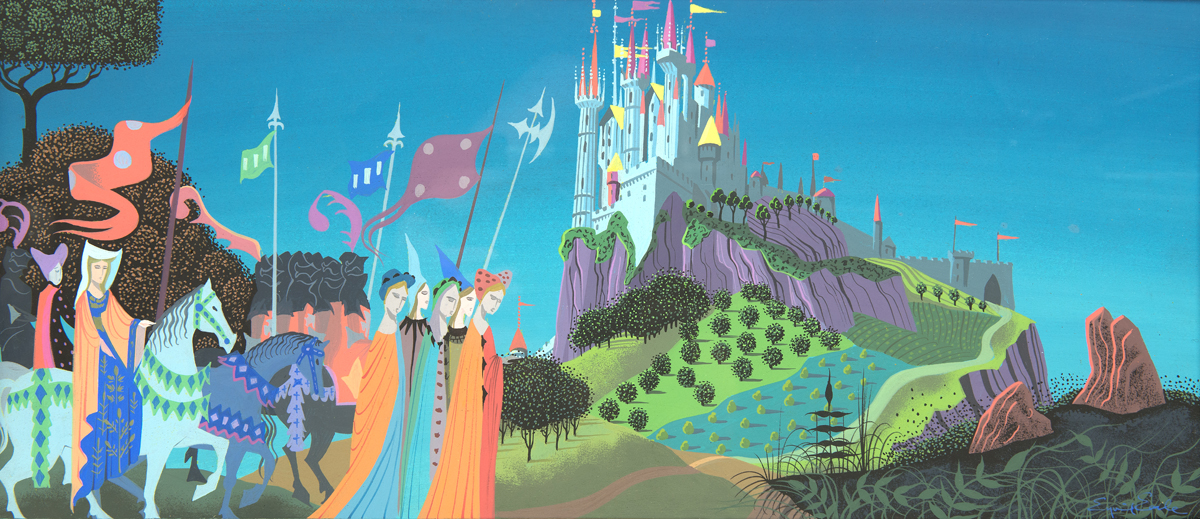 |
| Eyvind Earle, Concept art from Sleeping Beauty (Walt Disney Productions), 1958 Hilbert Collection, Chapman University. (c) Disney Enterprises, Inc. |
Last winter the Metropolitan Museum pleased more tourists than critics with
an exhibition on Walt Disney's sources in French decorative arts. The Getty now has a show that sounds comparable but is several degrees more clever. "The Fantasy of the Middle Ages" traces the roots of
Game of Thrones, Harry Potter, the
Lord of the Rings, and other modern entertainments in medieval art and life, mostly by way of the Getty's collection of illuminated manuscripts. As with the Met show, you'll see Eyvind Earle's concept art for Disney's
Sleeping Beauty (1959), steeped in the
Très Riches Heures of the Limbourg Brothers. But there are a lot of other franchises in play, as well as a more interesting social history. Disney used historic art for authenticity. "The Fantasy of the Middle Ages" is more about how a misunderstood epoch became a blank slate for the Western imagination.
To underscore that, the two-room show begins in a sunlit atrium with display cases of faux medieval toys, books, games, DVDs, and cosplay costumes lent by Getty staffers.
 |
| Isfandiyar Attacks the Simurgh from an Armored Vehicle, Shiraz, about 1485-95. LACMA |
The first historic artwork on view is a knight fighting a dragon. But it's a 15th-century Persian miniature from Shiraz, a reminder that Europeans often borrowed their medieval imagery from Asia, and vice-versa.
 |
| Dragon in a French bestiary of about 1270. J. Paul Getty Museum |
 |
| Frederic Theodore Lix, The Sleeping Beauty in the Wood, illustration to a 1890 edition of Charles Perrault's Fairy Tales. Fine Arts Museums of San Francisco |
Vasari used "gothic" as a pejorative for pre-Renaissance architecture. Centuries later, the collections of fairy tales assembled and retold by Charles Perrault, the Grimm Brothers, and Hans Christian Andersen promoted a more sympathetic (if misinformed) view of the middle ages. "Once upon a time" meant a simpler past time, but how far back was left to the imagination.
 |
Julia Margaret Cameron, The Parting of Sir Lancelot and Queen Guinevere, 1875
|
Romantic conceptions of medieval life burgeoned in the later 19th century with the Pre-Raphaelites, the tableaux vivant photography of Julia Margaret Cameron, and the gothic revival in architecture. Even at Notre Dame, it was felt necessary to add brand-new (19th-century) gargoyles to meet evolving expectations about medieval architecture.
 |
| Léopold Louis Mercier, Gargoyle, Notre-Dame, Paris, 1880s |
The show's central and perhaps unanswerable question is: Why have the middle ages had such an enduring grip on the modern imagination?
There are many fictional treatments of Greco-Roman antiquity, a period that was more influential on Western thought. But Spartacus and I, Claudius are costume dramas, bound to a particular historic epoch. Medievalism has remained firmly unstuck in time. The Lord of the Rings, Dungeons and Dragons, Game of Thrones, and even "Renaissance" fairs are not anchored to any real time or place, yet they read as medieval nonetheless.
 |
| Hans Baldung, Witches' Sabbath, 1510. Fine Arts Museums of San Francisco |
The most famous medieval monarch, King Arthur, is untraceable to history. Pop medievalism is more about an ever-shifting kaleidoscope of motifs: dragons, knights, castles, wizards, witches, and fairies. The first three are amply documented in manuscripts. The last three were footnotes to the medieval worldview, but they have been elaborated by later writers and artists. The Getty exhibition has a famous chiaroscuro print of a Witches' Sabbath by Hans Baldung Grien and a prime example of Victorian fairy painting by John Anster Fitzgerald. That eccentric British movement drew on Shakespeare's A Midsummer Night's Dream rather than its medieval sources. Fitzgerald's insect-like fairies must have been influenced by Bosch and Ruskin, as well as by political caricature. (Check out Rudy Giuliani at far left.)
 |
| John Anster Fitzgerald, Fairies in a Bird's Nest, about 1860. Fine Arts Museums of San Francisco |
 |
| Rockwell Kent, Sir Thomas in Geoffrey Chaucer's The Canterbury Tales, translated by J.U. Nicolson, 1930. Fine Arts Museums of San Francisco |
Architecture's medieval revival led to the Arts and Crafts movement, a precursor to modernism. In that sense, all that is modern or postmodern is medieval. Underscoring that is a pop-up book castle that Andy Warhol and Factory created in 1967. The caption works just as well for 2022:
We're attacked constantly.
"The Fantasy of the Middle Ages" was organized by Larisa Grollemond and Brian C. Keene and is accompanied by a publication. The exhibition runs through Sep. 11, 2022.
 |
| Andy Warhol, pop-up from Index Book, 1967 |










Comments
> Walt Disney's sources in French decorative arts.
If I didn't know better, I'd swear that presentation had been done at the AMPAS museum or the upcoming Lucas museum. LOL.
https://youtu.be/0E-XubQ8JeY
^ The lack of artistic skill evident in that animatronic is quite noticeable.
That company needs to hire someone like this...
https://youtu.be/MTUgyklPudc
In the meantime, the Metropolitan/Louvre, Govan/Zumthor/LACMA/Broad, AMPAS/Lucas, the Soumaya, the OMA/Perez, the Disney Company/political figures, etc, are becoming one big blur of "standards and scholarship are altogether in the eye of the beholder."